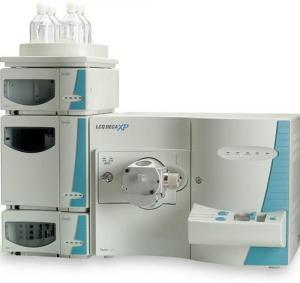1) tandem mass spectrometry(MS/MS)


串联质谱技术
1.
This paper gives a brief introduction about characteristic and utilization of MS relevance technologies,such as gas chromatography/mass spectrometry(GC/MS)、tandem mass spectrometry(MS/MS),etc.
简述了质谱相关技术,如气相色谱/质谱技术(GC/MS),串联质谱技术(MS/MS)等在火灾物证鉴定中的应用。
2) high performance liquid chromatography/electrospray tandem mass spectrometry


液相色谱/电喷雾-串联质谱联用技术
3) tandem mass spectrometry


串联质谱
1.
Study of application of the tandem mass spectrometry in the differential diagnosis of organic acidemias;
串联质谱技术在有机酸血症鉴别诊断中的应用
2.
Rapid detection of powdered antibiotics by surface desorption atmospheric pressure chemical ionization tandem mass spectrometry
表面解吸常压化学电离串联质谱快速检测粉末状抗生素药品
3.
By tandem mass spectrometry "sequence docking" method on Q-TOF2(Waters,USA),full(amino) acid sequence of C-terminal peptide of acidic fibroblast growth factor was analyzed and the adding site of sodium ion was proline(~6Pro.
用QuattroM icro三级四极串联质谱分析常见的20种氨基酸的加钠效果。
4) MS/MS


串联质谱
1.
An Algorithm Identifying Mutations and Post-translational Modifications of Proteins Based on MS/MS;
一种基于串联质谱鉴定蛋白质突变和翻译后修饰的算法
2.
As to MS/MS,multi-reactions monitoring(MRM)scan mode was employed.


方法:用三重四级杆串联质谱(MS/MS)作为HPLC的检测器,其中MS/MS使用了多反应检测(MRM)扫描方式。
3.
Methods Two-dimensional gel electrophoresis(2-DE) coupled with anti-phosphorylated-tyrosine antibody immunoblotting and electrospray ionization-quadrupole time-of-flight MS/MS(ESI-Q-TOF MS/MS) were performed to identify differential.
方法:采用双向凝胶电泳技术(2-DE)分离NPC组织与正常鼻咽上皮组织的总蛋白质,蛋白质转膜后与抗酪氨酸磷酸化抗体进行Western印迹分析,图像分析识别差异磷酸化蛋白质点,电喷雾-四极杆-串联质谱(ESI-Q-TOF MS/MS)鉴定差异的酪氨酸磷酸化蛋白质,采用NetPhos软件预测蛋白质的酪氨酸磷酸化位点,并采用生物信息学方法对差异磷酸化蛋白质的功能和亚细胞定位进行分析。
5) the combined technique of mass spectrometry


质谱联用技术
1.
The present status of resonance Rayleigh scattering,atomic adsorption spectroscopy,phosphorescence spectroscopy and the combined technique of mass spectrometry used in pharmaceuticals analysis at home and abroad was elaborated.
综述了国内外近年来共振瑞利散射法、原子吸收光谱法、磷光光谱法和质谱联用技术在药物分析中的研究与应用。
6) GC/MS technique


色-质谱联用技术
补充资料:液相色谱质谱联用系统

液相色谱质谱联用系统
主要用途: 1 蛋白,核酸测序, 二硫键定位 2 蛋白翻译后修饰分析 3 生物大分子间相互作用 4 分子结构解析 5 药物代谢途径分析 6 农药残留分析, 食品检测
仪器类别: 03030706 /仪器仪表 /成份分析仪器 /色谱质谱联用仪
指标信息: 液相系统:agilent 1100, 在线脱气, 泵:四元泵梯度泵,单元泵, 自动进样器 柱温箱 检测器:二极管阵列检测器, 荧光检测器质谱系统-finnigan lcq deca xp mass spectrometry 离子源, esi, apci 质量范围:50~4000, 蛋白 2000 – 20000 多级质谱, msn, n=10 控制软件: xcalibur 1.2 分析软件: biomass, turbosequest
附件信息: 无
机组简介: 高效液相色谱-质谱联用系统主要通过分析物质的分子量及元素组成等研究分子的结构等方面的信息。在生物、医药、农业、化学、精细化工等方面均可应用:
1.蛋白质和多肽的研究(蛋白的分子量测定及序列分析,肽谱测定,巯基及二硫键定位,蛋白质翻译后修饰分析-磷酸化、糖基化或化学修饰位点的确认等);
2.寡核苷酸和核酸的分析;
3.多糖的结构的研究;
4.中药活性组份和其它天然产物的分析、鉴定;
5.药物代谢产物的分析;
6.食品添加剂的分析及农药残留测定等
说明:补充资料仅用于学习参考,请勿用于其它任何用途。